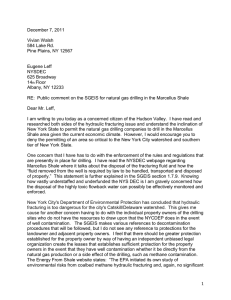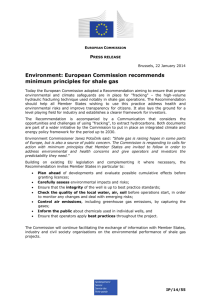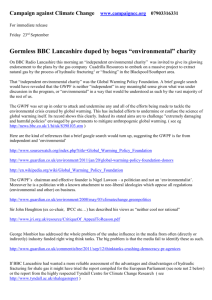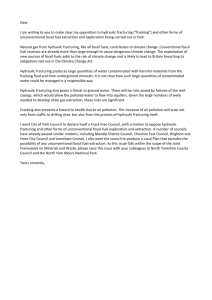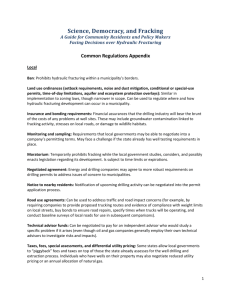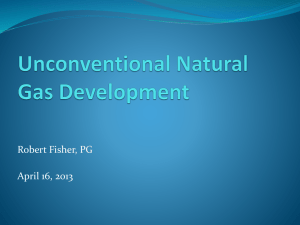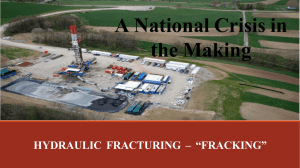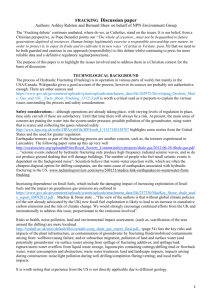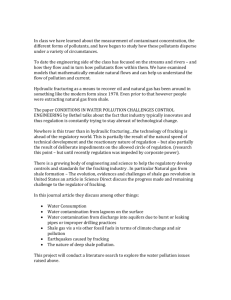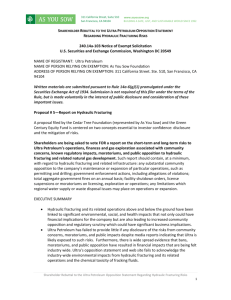F Resolution Concerning Hydraulic Fracturing
advertisement
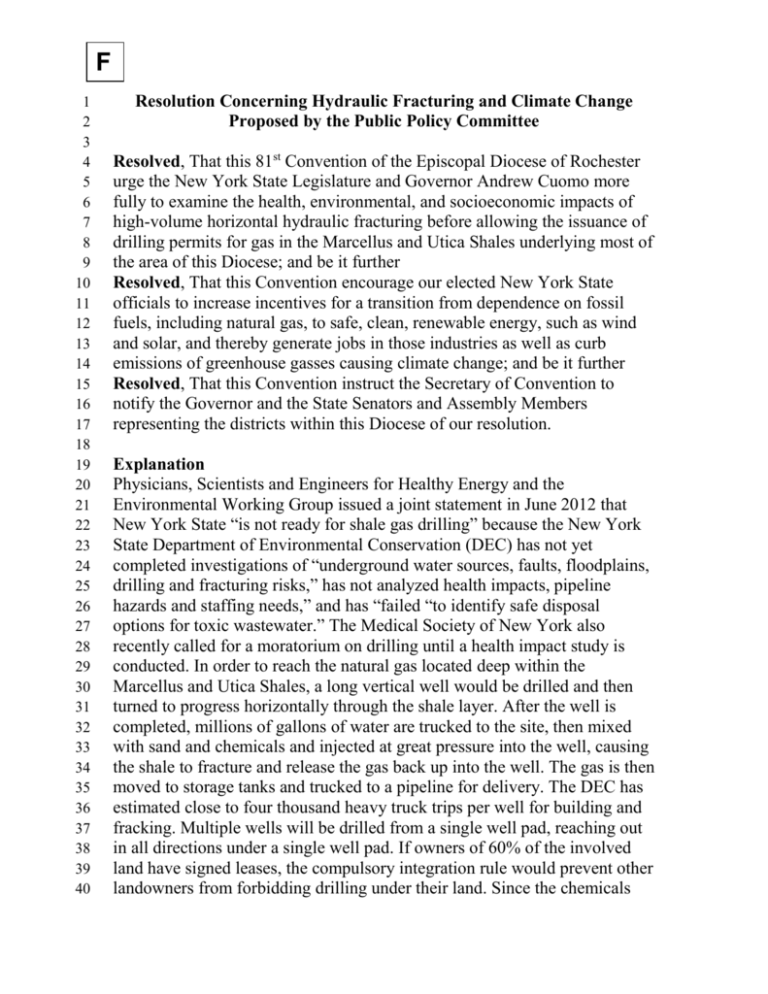
F 1 2 3 4 5 6 7 8 9 10 11 12 13 14 15 16 17 18 19 20 21 22 23 24 25 26 27 28 29 30 31 32 33 34 35 36 37 38 39 40 Resolution Concerning Hydraulic Fracturing and Climate Change Proposed by the Public Policy Committee Resolved, That this 81st Convention of the Episcopal Diocese of Rochester urge the New York State Legislature and Governor Andrew Cuomo more fully to examine the health, environmental, and socioeconomic impacts of high-volume horizontal hydraulic fracturing before allowing the issuance of drilling permits for gas in the Marcellus and Utica Shales underlying most of the area of this Diocese; and be it further Resolved, That this Convention encourage our elected New York State officials to increase incentives for a transition from dependence on fossil fuels, including natural gas, to safe, clean, renewable energy, such as wind and solar, and thereby generate jobs in those industries as well as curb emissions of greenhouse gasses causing climate change; and be it further Resolved, That this Convention instruct the Secretary of Convention to notify the Governor and the State Senators and Assembly Members representing the districts within this Diocese of our resolution. Explanation Physicians, Scientists and Engineers for Healthy Energy and the Environmental Working Group issued a joint statement in June 2012 that New York State “is not ready for shale gas drilling” because the New York State Department of Environmental Conservation (DEC) has not yet completed investigations of “underground water sources, faults, floodplains, drilling and fracturing risks,” has not analyzed health impacts, pipeline hazards and staffing needs,” and has “failed “to identify safe disposal options for toxic wastewater.” The Medical Society of New York also recently called for a moratorium on drilling until a health impact study is conducted. In order to reach the natural gas located deep within the Marcellus and Utica Shales, a long vertical well would be drilled and then turned to progress horizontally through the shale layer. After the well is completed, millions of gallons of water are trucked to the site, then mixed with sand and chemicals and injected at great pressure into the well, causing the shale to fracture and release the gas back up into the well. The gas is then moved to storage tanks and trucked to a pipeline for delivery. The DEC has estimated close to four thousand heavy truck trips per well for building and fracking. Multiple wells will be drilled from a single well pad, reaching out in all directions under a single well pad. If owners of 60% of the involved land have signed leases, the compulsory integration rule would prevent other landowners from forbidding drilling under their land. Since the chemicals 41 42 43 44 45 46 47 48 49 50 51 52 53 54 55 56 57 58 59 60 61 62 63 64 65 66 67 68 69 70 used in the fracking process have not been made public, we cannot adequately assess the potential health problems. Risk of pollution to ground water is possible because 30%-70% of the fluid pumped into the well flows back out after accumulating additional contaminants such as arsenic and radioactive materials. This wastewater has not been classified as hazardous. Current water treatment plants may not be able to process these wastes. The high risk of water pollution led to the banning of hydraulic fracturing in the New York City and Syracuse watersheds. Natural gas when burned for fuel may release less carbon dioxide and mercury than coal. However, the primary constituent of natural gas is methane, a much more potent greenhouse gas than carbon dioxide. Also, methane has been emitted from wells in Pennsylvania during the return of fracking fluids to the surface. The economic benefits of hydrofracking have been stressed by the gas industry, but the costs to the communities of infrastructure repairs from all the heavy truck traffic have not been weighed fully. Gas extraction in New York could end in less than thirty years when the supply of gas is predicted to be exhausted. Meanwhile, damages to the agriculture and tourism industries would be permanent. Many local bans and moratoria have already been enacted in the state, including several within the Diocese. The Episcopal Dioceses of Ohio and Southern Ohio passed resolutions at their Convention last fall “to put on hold additional issuance of fracturing permits until concerns of scientists and Ohioans are addressed.” One resolution at General Convention in July 2012 calls for us “to resist the development and expansion of ever more unconventional and environmentally destructive sources of fossil fuel and move toward conversion to more sustainable sources” (B023), and another resolution asks us to “advocate for public policy to reduce climate changing emissions” (D055). This resolution before you calls the Diocese to join in this effort. Resolution F Adopted as Amended 71 72 73 74 75 76 77 78 79 80 81 82 83 84 85 86 87 88 89 90 91 92 93 94 95 96 97 98 99 100 101 102 103 104 105 106 107 108 109 110 111 112 113 Sources Consulted In Research for the Hydraulic Fracturing Resolution Barth, Jannette M., PhD. “Preliminary Comments and Questions Regarding the Economic Assessment Report for the Revised Draft SGEIS.” 10 October 2012: www.catskillcitizens.org/sweeney_20111006/barth.doc. Department of Environmental Conservation (DEC). Supplemental Generic Environmental Impact Statement (SGEIS). Revised November 2011: http://www.dec.ny.gov/energy/46288.html. Earthworks. “Loopholes for Polluters: The Oil and Gas Industry’s Exemptions to Major Environmental Laws.” By Lauren Pagel and Lisa Smith. 16 May 2011: www.earthworksaction.org/library/detail/loopholes_for_polluters. Environmental Working Group and Physicians, Scientists and Engineers for Healthy Energy. “Ten Problems with New York’s Shale Gas Drilling Plan.” 13 June 2012: www.static.ewg.org/pdf/top-ten-ny-drilling-problems.pdf. Episcopal Diocese of Ohio. “Resolution Concerning High-Volume, Horizontal Hydraulic Fracturing.” November 2011: www.dohio.org/resolutions/987-r5-resolution. Episcopal Diocese of Southern Ohio. “Concerning the Practice of High-Volume, Horizontal Hydraulic Fracturing, Known as Fracking.” November 2011: www.eenonline.org/educate/resolve/2011/res-SOH-11.htm. Food & Water Watch. How New York State Exaggerated Potential Job Creation from Shale Gas Development. 29 November 2011: www.foodandwaterwatch.org . Fox, Josh. Gaslands: A Film. DVD 2010. General Convention of the Episcopal Church Resolutions on Climate Change: B023 and D055. July 2012: www.generalconvention.org/gc/resolutions. Headwaters Economics. “Fossil Fuel Extraction as a County Economic Development Strategy: Are Energy-focusing Counties Benefiting?” Revised 11 July 2009: www.headwaterseconomics.org/energy/Headwaterseconomics_EnergyFocusing.pdf. Kolbert, Elizabeth. “Burning Love.” The NewYorker. 5 Dec. 2011: 25-26. Print. Krueger, Liz. Testimony before the NYS DEC. 30 Nov. 2011. Google Liz Krueger’s Fracking Testimony. Krugman, Paul. “Natural Born Drillers.” TheNewYorkTimes. 15 March 2012: Print Version 16 March 2012: A27. Public Policy Committee of the Roman Catholic Diocese of Rochester. Google Public Policy Committee of the Roman Catholic Diocese of Rochester. Under Continuing Education Issues,” click on Energy Issues/Global Climate Change. Scroll down to Resources to read these two documents: Hydrofracking 101 Diocesan Public Policy Testimony on Proposed Hydraulic Fracturing Regulations. (Rev. Brian Cole, Dansville, 16 Nov. 2011). Rochesterians Concerned About Unsafe Shale-gas Extraction (R-Cause). http://www.r-cause.net
